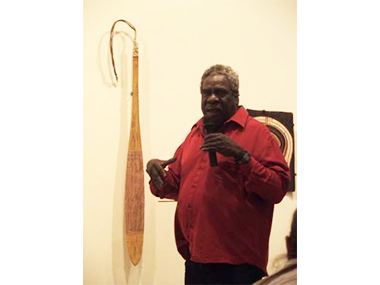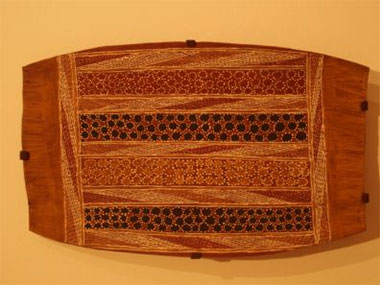MILINGIMBI MEMORIES

Milingimbi artist Michael Mungula talking about his father, Djawa's duck-wing bull-roarers at the Art Gallery of NSW
Posted by Jeremy Eccles | 15.11.16
Gallery: Art Gallery of NSW
Dates:
12.11.16
: 29.01.17
In August, I wrote about the ceremonial makarrata that was held on the Crocodile Island of Milingimbi, off Arnhemland that bound the 53 signatories to its final agreement to make an effort within 12 months to bring their collected art and artefacts from Milingimbi to public notice. Most of these collections date back to the island's prolific 1950s and 60s. For then, an eager Methodist missionary – Rev Edgar Wells – encouraged and collected artists' work and sold it through both Mission stores in Australia and a dealer in none other than Berkeley Square, London; he also brought in anthropologists and institutional collectors from around the world such as Ed Ruhe from America and Karel Kupka from France.
Thus scattered a trove. And, following the art, the artists lost their patron on their sandfly infested island as official art centres sprung up elsewhere, at Ramingining and Maningrida on the mainland and on Elcho Island. Many went with this flow; those that stayed, learning from the masters of those years such as Binyinyuwuy, Buranday, Dayngangan, Dawidi, Djäwa, Djimbarrdjimbarrwuy, Lipundja, Malangi and Makani, had to sell through those other art centres, and buyers' eyes ceased to be attuned to the individuality of Milingimbi.
Now, the first cab off the institutional rank – the Art Gallery of NSW – has revealed its rich collection, one that makes up 10% of its Indigenous art holdings. 'Taking Memories Back' – the show's title – is a quote from artist Djawa's academic son, Dr Joe Gumbula, who dedicated his life to viewing those widespread collections in order to “restore all of the information about the clans. That will make things easier for later researchers. We have to go through the guidelines so people will know the correct information”.
Curator Cara Pinchbeck at AGNSW has taken the same line, coming up with an example of curatorship as god intended – well-informed with fascinating anthropology that serves to enhance the artistry. “There's no point in having a collection if you don't know about the works”, she insisted at the exhibition's opening. Does this suggest that other Indigenous curators who are reluctant to share such information with their viewers may actually be ignorant of meaning, not having done the sort of follow-up that Pinchbeck has done during annual visits to Milingimbi?
The AGNSW's good fortune in 1962 was, of course, Deputy Director and artist, Tony Tuckson. Having had his eyes opened on the 1958 Scougall expedition north to the Tiwi Islands when 17 Pukumani Poles were famously commissioned, Tuckson was more than open to donations of Milingimbi barks from Scougall in 1961 and to buying the Rev Wells's collection the following year. Interestingly, funds for that purchase came from what was still then called 'The Primitive Art Collection'. Melanesian art also entered the Gallery collection in 1962 for the first time under that same heading.
So, what's on show today of that history-making era?
The upstairs temporary gallery at AGNSW looks beautiful in its generously spaced hang. Approximately 125 works are displayed – from the many barks to model canoes, string baskets to spears, and ceremonial strings to bull-roarers.
This last came as a real surprise because the secret/sacred political correctness surrounding these objects/musical instruments is notorious. It's said that a mere sighting of a bull-roarer can bring back existential memories of the pain suffered by every tribal man during his initiation. At the Australian Museum, hundreds are locked away. Yet here are four splendid examples by Djawa – one a mighty 116 cms long – decorated with designs related to the diver duck – Burala. Indeed, the words bull-roarer doesn't appear in the gallery or the catalogue. But could Burala have inspired the English words??? We were also assured by Djawa's son, Michael that the sound produced by swinging these wooden ducks matched the sound the duck's wings in flight, and that his late brother Joe had approved the items for public display.
Another surprise for me was the sheer artistry of much work: Buranday's bark, 'Gurrpulu, flood plain at sunrise' is just not the sort of subject I expected from these keepers of the Djang'kawu Sisters legend or such tellers of the Wagilak story. Yet there I was transfixed by the bark's achievement of the glitter of early morning light on the flood plain's waters.
Nearby, David Malangi's modestly entitled 'Food Pattern of Trees' offers alternating dark and light leaves on either side of two branches, surrounded by a haze of white dots. In the centre, a multi-coloured zig-zag deceptively divides the branches. For this, it turns out, was the King Brown Snake that crept up on the hunter Gunmirringu as he feasted on those white bush berries and killed him with one envenomed strike of the tongue – bringing death into the Yolgnu world for the first time! I'd known of the Purukupali story from Tiwi, which introduced death into their world. But had no idea that immortality was so widespread in Aboriginal legend that death had to be invented and justified.
Binyinyuwuy's 'Trees and Flying Fox Camp' has something of the same abstract patterning hiding a wealth of story, suggesting that there was considerable freedom to interpret important myths as an artist wished in Milingimbi in the 1950s. Or as archivist Stephen Miller puts it, “This comparatively restrained composition successfully reduces these associated yet divergent realities (the flowers on the trees and the droppings of the sated flying foxes as they fly over water – giving it its power) to an identifiable visual code or abbreviation”.
Of course, it was especially pleasurable to see all these works in the company of descendants of these great artists. For a gaggle of current painters from Milingimbi was in town for both this show and a show of their own works at Gabriella Roy's Aboriginal & Pacific Art Gallery in Danks Street – her last show, by the way, before that fruitful art hub closes. Especially affecting were the words of Joyce Naliyabu at the opening: “With future generations going faster and faster and government policies changing so quickly, it's good to have a quiet place like this where kids can come and think about their grandparents, to put our culture into their hearts”. And I presume that Naliyabu's definition of “quiet place” extends to the art centre at Milingimbi where the artworks on show in Sydney are available for viewing and discussion electronically.
The existence of the AGNSW show certainly stimulated art activity on the island. Unfortunately, the seasonality of bark's availability meant that many paintings appear at Danks Street on rectangular boards. But many people are reluctant bark buyers, anyway, because of its instability. And the art looks pretty good on boards, which are for sale until 30th November. The next bark-hunting season during Milingimbi's Autumn could well produce an explosion of work.
URL: http://www.artgallery.nsw.gov.au/exhibitions/milingimbi/
Share this:
»  del.icio.us
»
del.icio.us
»  Digg it
»
Digg it
»  reddit
»
reddit
»  Google
»
Google
»  StumbleUpon
»
StumbleUpon
»  Technorati
»
Technorati
»  Facebook
Facebook
Contact Details
Gallery: Art Gallery of NSW
Contact: Cara Pinchbeck - Curator of Aboriginal and Torres Strait Islander Art
Email: artmail@ag.nsw.gov.au
Telephone: +61 2 9225 1700 or 1
Address: Art Gallery Road Sydney Sydney 2000 NSW
Gallery: Art Gallery of NSW
Contact: Cara Pinchbeck - Curator of Aboriginal and Torres Strait Islander Art
Email: artmail@ag.nsw.gov.au
Telephone: +61 2 9225 1700 or 1
Address: Art Gallery Road Sydney Sydney 2000 NSW

Contemporary Milingimbi art on the walls of the Aboriginal & Pacific Art Gallery in Danks Street

Binyinyuwuy's 'Trees and Flying Fox Camp' painted in the 1950s and sold to the AGNSW from the collection of the Rev Edgar Wells
Where is the exhibition?
Further Research
Gallery: Art Gallery of NSW
Artists: Binyinyuwuy | Buranday | Dawidi | Dayngangan | Djimbarrdjimbarrwuy | Djäwa | Joyce Naliyabu | Lipundja | Makani | Malangi | Michael Mungula
News Tags: AGNSW | bull roarers | Cara Pinchbeck | Dr Gumbula | Gabriella Roy | Jeremy Eccles | Milingimbi | Tony Tuckson
News Categories: Australia | Blog | Exhibition | Feature | Industry | News
Exhibition Archive
- 10.10.17 | TARNANTHI 2017
- 11.08.17 | Natsiaas 2017
- 20.07.17 | APY ART DOMINATES THE WYNNE
- 17.07.17 | Anangu Artist Wins $100,000 Prize
- 14.07.17 | The End of AAMU
- 11.07.17 | ART ACROSS THE COUNTRY
- 11.07.17 | TARNANTHI IN OCTOBER
- 05.07.17 | TJUNGUṈUTJA - from having come together
- 13.06.17 | Ghost-Nets Straddle the World
- 07.06.17 | Grayson Perry Going Indigenous?
- 05.06.17 | Barks Bigger than Ben Hur
- 27.05.17 | NGA QUINQUENNIAL 2017
- 21.05.17 | Blak Douglas Finds Home at the NGA
- 21.05.17 | BRIAN ROBINSON WINS HAZELHURST WOP
- 18.05.17 | PARRTJIMA 2.0
Advertising

